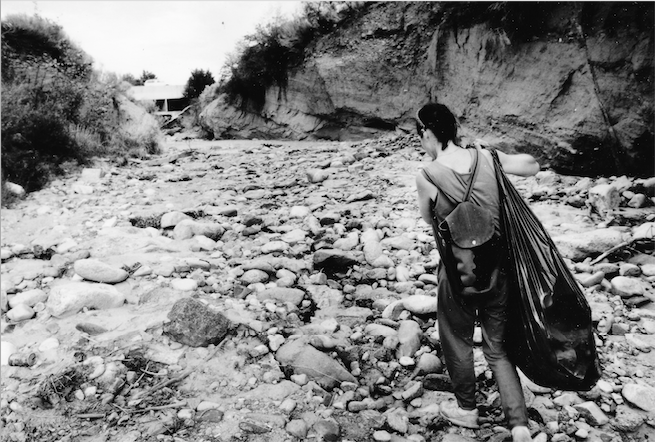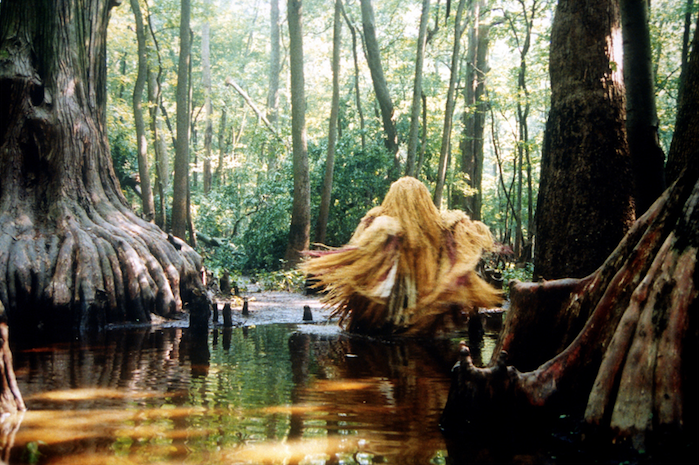
Helène Aylon (American, 1931-2020), The Earth Ambulance, 1982 ©Estate of Helène Aylon
But Is It Ecofeminist?
by Mary Jo Aagerstoun, PhD
Two exhibitions of art by women opened simultaneously in June 2020 within the menacing shadow of the COVID 19 pandemic, one in Santa Fe: Performative Ecologies, curated by Patricia Watts, at the new media gallery Currents 826, on June 9, 2020, and the other in New York City: ecofeminism(s), at the Thomas Erben Gallery, curated by Monika Fabijanska, on June 16, 2020. The shows’ appearances—the audiences mainly viewed the exhibitions online—also coincided with the righteous mobilizations and demands of Black Lives Matter spilling across the US in reaction to the murder of George Floyd by police. (1)
Neither ecofeminism(s) nor Performative Ecologies included works by Black women artists. A review of ecofeminism(s) in The Brooklyn Rail vividly underscored this absence. (2) The review’s author, Darla Migan, also asserts that an ecofeminism show foregrounding white women proved the ecofeminist movement and philosophy is “anti-intersectional” and “essentialist.” This point of view is not new and has stuck to the ecofeminist movement since its beginnings.
It was in this context that I received Patricia Watts’s invitation to write this essay on the two exhibitions for the online cultural platform, ecoartspace.(4) As I prepared to write the review I communicated with both Watts and Monika Fabijanska, asking them how they had chosen the artworks for their shows and why they had not included works by Black woman artists.(5) They both responded with reasons for the absence of Black women artists’ work and with statements of resolve that they intended to rectify this absence as they moved forward with their respective curatorial practices. They also offered detailed descriptions of their intentions for the exhibitions and their criteria for selecting the works.
Darla Migan's critique of Black women artists’ absence from ecofeminism(s) is legitimate and can be equally applied to Performative Ecologies. There certainly are Black women artists who address relationships with the environment in a range of ways and whose works might have fit (easily or uncomfortably) in either show. Among these are the philosophically dense abstractions and performances of Torkwase Dyson, the lyrical, landscape-based photo-narratives of Allison Janae Hamilton, and the community-embeddedness of LaToya Ruby Frazier’s 2016 Flint Project. The inclusion of Black artists’ perspectives in future exhibitions of art by women concerned with environmental damage and crises will be something to look forward to!(6)
While an in-depth exploration of whether ecofeminist analysis is an appropriate lens through which to consider works by Black women artists concerned with environmental issues would be welcome, this essay will not elaborate on the absence of their work in these shows, aside from asserting the legitimacy of the criticism leveled by Migan. This essay will consider whether the works in these exhibitions engage ecofeminism, the relationship they might have with essentialism and whether they can be seen as deploying ritualistic characteristics to oppose and resist.
As I began to think about all this, I wondered if the curators' intentions could be divined by considering their exhibition titles. Watts’s title, Performative Ecologies, seems gender-neutral, though all the artists in her show were women. She intentionally selected self-performative, ritualistic works where the artists appear alone (and sometimes nude) in landscapes, suggesting a possible essentialist valence that could connect with some of ecofeminism’s early tendencies to make strong, frequently celebratory linkages between biological women and the alleged feminine identity of Nature.
Fabijanska's title, ecofeminism(s), suggests the curator intended to foreground ecofeminist politics and activism in her show. Yet, in an email to me, Fabijanska states she did not intend the show to be "a piece of theoretical writing," because she expected her audience to be unfamiliar with either feminist or ecological art.(7) She wanted instead “to emphasize certain similarities and differences, to create the energy of pluses and minuses (think batteries): shapes, textures, sizes, colors, and content” to encourage gallery visitors to think deeply about what they were seeing.
Though Watts does not claim her exhibition engages ecofeminism, she has long pursued an interest in how artists (primarily women, but some men as well) place themselves in landscapes, alone, and in performative ways.(8) Emphasis on imagery of female artists, often nude, embedded ritualistically in landscapes, could suggest a fixed, universal—essentialist—relationship between Woman and Nature. At the same time, the artists’ intentions, or the works’ manifestations themselves, can also be seen as (directly or tangentially) political or activist.
Active opposition to all forms of oppression has been ecofeminists’ focus throughout the evolution of the movement and its discourses. Ecofeminists point to this focus as evidence of ecofeminism’s firmly embedded history of intersectionality. Could activist, resistant, or oppositional intent or manifestation influence whether a ritualistic work is interpreted as ecofeminist, but not essentialist, even when ritualistic and spiritual aspects are dominant? What makes a work spiritual or ritualistic? And how are we to interpret works that suggest activist intent but convey this in ritualistic ways?
Scholar of ritual Ellen Dissanayake identifies particular characteristics of ritual.(9) She posits that ritual is characterized by “unusual behavior that sets it off from the ordinary or everyday” and that the place where ritual is enacted is “made special” by such behavior. She argues that “[t]ime, space, activity, dress, and paraphernalia are all made special or extraordinary by unusual behavior, and so we can speak of ritual time, ritual space, ritual activity, ritual dress, ritual paraphernalia. . .” Works in both shows display various combinations of these characteristics.
For example, some artists in both exhibitions choose to perform in, or refer to, damaged and even dangerous sites or to perform potentially physically dangerous or risky acts. Such choices draw attention to these sites, clear evidence of political and activist intent. If attention is not drawn to a situation of damage, the damage may never be addressed.

Dominique Mazeaud (French American 1942-), The Great Cleansing of the Rio Grande 1987-1994 ©Estate of Dominique Mazeaud. Courtesy of the artist
One work of this type, in Performative Ecologies, is Dominique Mazeaud’s seven-year-long The Great Cleansing of the Rio Grande (1987-1994). Repetition and endurance are characteristics of ritual, and are foregrounded in Great Cleansing. Mazeaud’s cleanups occurred in regular monthly sequences, stretching out over years, during which her community became increasingly involved in the project. Community members joined Mazeaud regularly in urging elected officials to improve enforcement of anti-littering regulations.
Mazeaud's Great Cleansing also spawned activist involvement after the project ended. In one of these later activist interventions, in 2001, as an act of opposition to the war in Iraq, she sent a box containing “gifts from the river,” children's shoes and other "talismanic" articles collected during an earlier Great Cleansing, to one of New Mexico's US Senators. The items referred to the deaths of thousands of children during US bombings.(10) The act of placing objects together in ways that suggest the arrangement itself has power is consonant with Dissanayake’s observations that objects become ritualized when utilized for a particular purpose that is not the objects’ original one.

Fern Shaffer (American, 1944-), Nine Year Ritual (1995-2003), The Swamp, 9th Ritual, September 9, 2003, Cashe River Basin, Illinois © Fern Shaffer. Courtesy of the artist
Another multiyear work in Performative Ecologies, Nine Year Ritual (1995-2003), by performance artist Fern Shaffer, a self-identifying feminist healer, took place on a succession of seriously damaged sites. The artist wore a costume suggestive of an African shaman, and the piece demonstrates several aspects of ritual as described by Dissanayake. Among the more recent works in Performative Ecologies is Mary Mattingly's Pull (2013), in which the artist, who self-identifies as an ecofeminist, first documented all her possessions, researching every detail about each item's provenance and manufacture, then gathered and bound the items into several large "boulders" and ritually pulled them, alone, through New York City's streets. In this way, Mattingly activates ritual processes of temporality and endurance to bring to sharp visibility the weight of human overconsumption and its exponentially expanding impacts on all habitats—clearly an activist intent.

Mary Mattingly (American, 1979-), Pull, 2013 © Mary Mattingly. Courtesy of the artist
continues here